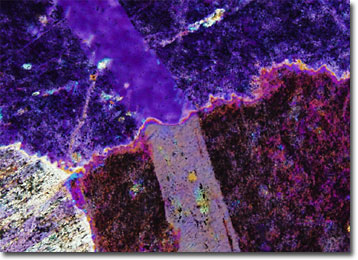Polarized Light Microscopy Digital Image Gallery
Soapstone
Soapstone is a type of metamorphic rock that has a characteristic feel, from which its common name derives. The chief mineral found in the rock is typically talc, but tremolite, mica, quartz, and chlorite are also common constituents.

View a second image of Soapstone
Widely utilized for thousands of years, soapstone is a relatively soft rock that can be readily carved into an array of items with a knife or other sharp object. It has been used since antiquity, for instance, to create sculptures, jewelry, and other ornaments, as well as more practical items, such as cooking utensils. In colonial America, soapstone gained significant use as a building material and became a particularly popular choice for sinks and fireplace hearths. Today, the rock, which varies from gray to green to brown in color, is also commonly used to create fashionable and functional countertops.
Despite its softness, soapstone is surprisingly durable. The rock is not damaged by moderate heat, alkalis, or acids, which makes it an excellent material for use in laboratories. Soapstone is also easily cared for because its poor absorbency keeps stains and discolorations from penetrating past a surface level. Thus, with a simple sanding, the rock can regain its original beauty. Application of mineral oil or a sealant to soapstone items can further enhance their resilience and make them even longer lasting.
